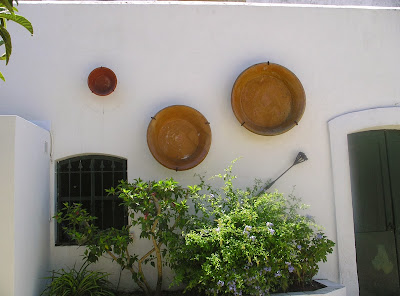I'm interested in interior design, especially with old houses and so I was thrilled when Oscar Olivier sent me this photograph of a Vejer kitchen. I love the way the owners have preserved the original features while including a modern hob, oven and refrigerator. use of beautifully preserved local limestone.
Naturally, it is nothing like the real kitchen used by most people in the past, which is better represented by this picture of women cooking in the Patio of the House of Widows. Some may say that it's a familiar picture. A woman stirs the pot while two gentlemen take a rest, deep in conversation. A pair of loaded mules stand in the background, one of them bearing the burden of a third man's elbow.
However, gender roles were strictly observed in 19th century Vejer. It was rare for women to work outside the home and those men and mules may just have completed an exhausting ascent of the Cuesta de la Barca, loaded with drinking water from the well there.
What catches my attention is how much of the cooking seems to have been done out of doors. I shouldn't be too surprised, because in my own patio there's an old outdoor kitchen, now turned over to plants.
This kitchen was probably shared by the four families who originally lived on the patio, and as the ground floor was mainly stables, we can imagine that a few interested equine faces showed up when a hot bran mash seemed likely to be on the menu.
If you glance into the patios you pass as you walk through Vejer, you'll sometimes see what looks like a well, often nicely decorated with potted plants.
But it isn't a well, it's an aljibe. There is no permanent source of fresh water in Vejer, something which has caused a lot of heartache over the years.
One of the things we take for granted in our kitchens now is a supply of running water, but in the 19th century, all but drinking water came from aljibes, underwater cisterns which stored rainwater. You can see the aljibe on the left, filled with plants.
Most aljibes were accessed from out of doors, but in larger and more modern houses, there was sometimes an access point indoors too.
In this house, water was raised by using a rope and bucket. The current owners preserved this feature by covering it with glass.
 |
| Bread oven, Casa de la Cultura |
An important culinary feature was the bread oven. In grand houses, the bread oven was housed indoors, as with this one in the Casa Tamarón, the present Casa de la Cultura.This oven can be seen whenever the casa is open.
However, in general, bread ovens were built outside the house, like this one on Arrieros. Bread was not baked every day, but about three times a week, depending on the needs of the family.
This Vejeriego from the Christmas Belén demonstrates the traditional art of making bread, though I don't know how he made that enormous loaf in the tiny oven you see behind him. However, he assured me that it was real bread and even gave me a slice to prove it.
Finally, I should mention the great earthenware vessels which were used for everything from washing clothes to serving food - the lebrillas. Records tell us that that these were made around Vejer from pre-Roman times. A nearly hamlet, Libreros, is named after the Roman pottery which once stood there.
Lebrillas are now only used for decoration but you will see plenty of them in the patios of Vejer, and especially in the Casa del Mayorazgo, where they are accompanied by washboards, brushes and all the other paraphernalia of pre-electronic washday.
.jpg)








No comments:
Post a Comment